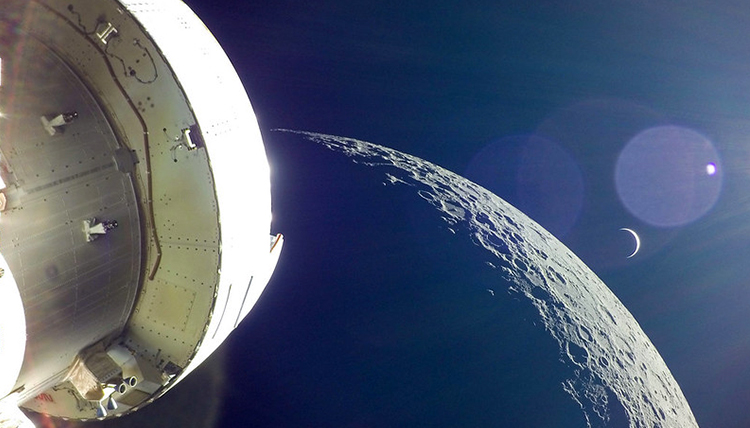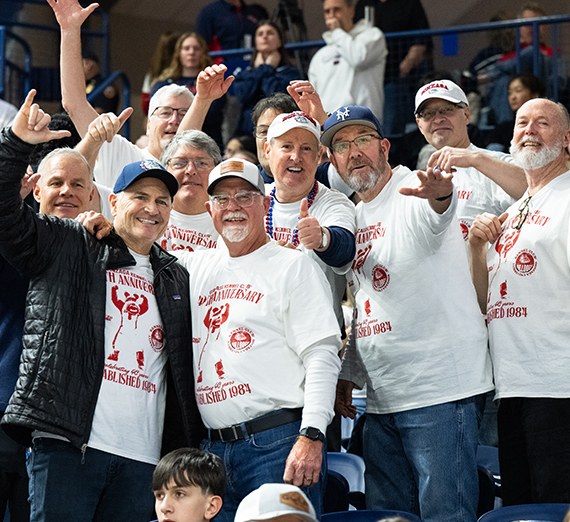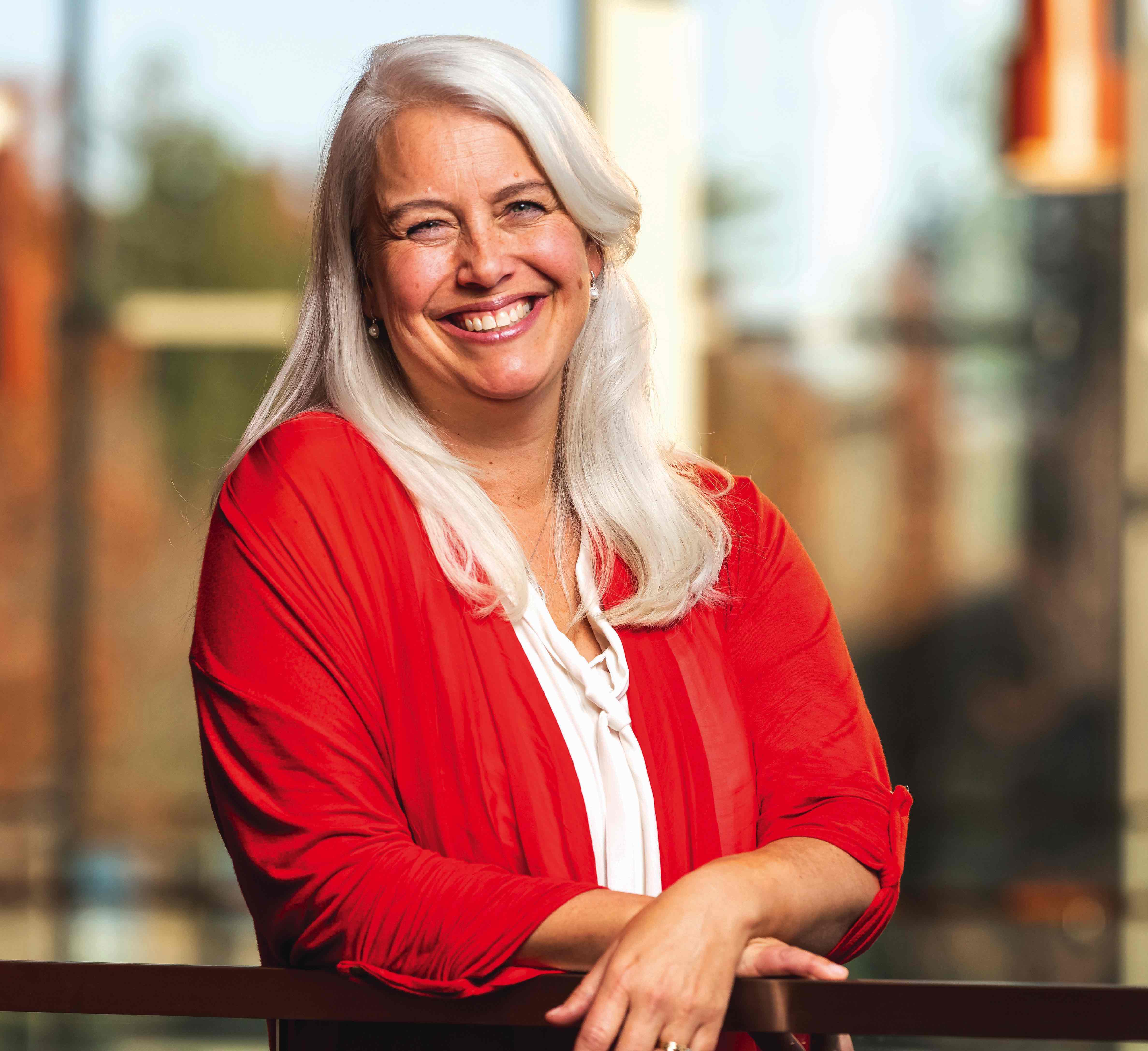Zags In Space

Richard Koelsch wouldn’t necessarily claim that “Star Wars” directly led him to his current job at the National Aeronautics and Space Administration (NASA).
But his childhood obsession with all things Jedi-related sure didn’t hurt in pushing Koelsch to explore worlds beyond his small southern Idaho hometown. He eventually landed at Gonzaga, earning a mechanical engineering degree in 2004.
Now he’s working on NASA’s most ambitious project in decades, building a small space station called Gateway that will orbit the moon and offer support for missions to push humanity farther into space than it’s ever gone — first on a mission called Artemis II taking astronauts on a loop out beyond the moon and back. Eventually, Gateway will help with deeper space exploration. Mars, anyone?
“I’m a huge ‘Star Wars’ fan, sci-fi in general, so I’ve always been attracted to space exploration,” the 43-year-old Koelsch says from Houston, home to NASA’s Johnson Space Center. And the idea of combining his love of space exploration and his passion for building and designing things, he says, was homegrown. “I was influenced by my dad who was always making something in his shop.
“I grew up in an Air Force base town (Mountain Home, Idaho), around airplanes and jets.
As any fan will tell you, there’s no such thing as watching it “too many times,” but while most sated their interest at repeated viewings and investing in collectibles, Koelsch turned his interstellar curiosity into a rewarding career, starting with his work at Gonzaga.
Making Space Feel Like Home
Koelsch’s official title at NASA is deputy system manager for the Environmental Control & Life Support Systems for the lunar space station Gateway. Prior to joining NASA and the Gateway project, he spent much of his career working on Orion, or the Multi Purpose Crew Vehicle that takes astronauts into deep space and returns them safely to Earth, and he’s continued working on Orion even as the Gateway project proceeds.
“My job is essentially to create a mini-Earth inside a space craft,” Koelsch explains. “Think about all the things we take for granted on a daily basis, as far as just breathing in oxygen — we have air in the atmosphere, and we have plants that scrub carbon dioxide we exhale. We can typically control the temperature around us. We have drinking water, facilities to use the bathroom. My job is to put all that minutiae into a spacecraft and make it habitable for the crew.”

Last fall, Koelsch was part of the team in Mission Control supporting the Artemis I mission, basically an unmanned test run that sent Orion out beyond the moon farther than any manned spacecraft has ever gone. NASA had to see if Orion could return safely with its humanity-supporting systems still functioning, and test if it could withstand the incredible speed and heat as it reentered Earth’s atmosphere from such a distance. And while NASA is still sifting through the data of the trip, Koelsch says Artemis I largely exceeded expectations, setting up Artemis II to take astronauts along perhaps as soon as 2024.
“It’s just something I’ll never forget,” Koelsch says of working on last year’s mission.
Looking back, part of me was reflecting on the accomplishment, and the other part of me didn’t want the mission to end — it was a significant milestone for me and my team.”
During a brief stop as a student-athlete at Whitman College in Walla Walla, Koelsch realized he wanted to pursue engineering and transferred to Gonzaga, where his older sister had gone and where his girlfriend (and eventual wife) Tammy Kerr (’03, nursing) was attending.
“When I came to Gonzaga, I wanted a career where I could basically design and build something,” Koelsch says. “As I got further along, I realized that, hey, I’ve always loved aerospace. Why not combine my love for building things with my love of space exploration?”
Critical Thinking for Critical Projects
Koelsch recalls late nights in the computer lab as he juggled a demanding major and playing tennis for the Zags, although he credits the intense time-management he had to learn on campus with helping him later in his career. He remembers watching friends play frisbee outside while he was holed up with his classmates “hammering away at various projects.” But the work paid off, leading him through graduate school at the University of Southern California, while working at Boeing and Lockheed Martin before landing at NASA.
Koelsch credits his Gonzaga professors and the small class sizes for giving him a leg up as he entered the competitive field of aerospace employment. But he reserves particular credit for the “liberal arts nature of Gonzaga” for giving him tools that he doesn’t necessarily see from his peers who graduated from much larger institutions.
“We had to take a religion and a philosophy course each year, and I really embraced that,” Koelsch says.
You have to have some critical-thinking ability and form logical arguments to back up your opinions with sound engineering. Gonzaga, in the way the liberal arts courses were set up, really helped me in that regard.”
The opportunities available to students at Gonzaga, such as engineering competitions, senior design projects and capstone projects, all proved valuable later on, Koelsch says, teaching him how to work as part of a team and with people offering different, if equally vital, skillsets.
“On a daily basis, I deal with multiple disciplines of engineers, sometimes scientists, sometimes physicians, and we talk about life support and keeping the crew healthy and alive,” Koelsch says. “Opportunities at Gonzaga prepared me for what it’s like in the real world, in terms of industry, where you have to be part of a team.”

"This is Orion coming around the Moon on its journey back home. This is significant for me because I was on console during this flyby. Orion was on its way home and swinging by the Moon; on the backside of the Moon, we do not have communication with the spacecraft (called LOS - Loss of Signal) which is expected. So during LOS we took a breather but when we came out of LOS the first thing we saw was that image which that moment was etched in my memory." (photo courtesy of NASA)
Whither Space
It can be easy to look around at the challenges here on Earth — rampant poverty, housing deficits, a global climate crisis — and question why America and other countries make the investment to go to space. Koelsch understands the debate, but he also believes it’s part of human nature to explore the unknown. He recalls how when Neil Armstrong set foot on the moon in 1969, “something like 600 million people watched that all over the world.” That incredible feat of scientific ingenuity captured the imagination of the world, and it still has a hold on many. “I work in a building at the Johnson Space Center that people tour on a daily basis. How many people can say they work in a building where tour groups are coming?”
“We want to know our place in the universe, and unless we go out and explore, we will never know that,” Koelsch says. “There are discoveries yet to be made. We are continuing to explore microgravity research at the International Space Station, and beyond that, space offers a lot of untapped resources that, if they’re used appropriately, could help life here on Earth.”
Koelsch hopes that a career that began with perhaps too many “Star Wars” viewings will end with him seeing a mission to Mars. It’s a trip considerably farther than the one Artemis II will make, but it’s getting closer all the time as the science advances. He knows that space exploration is a marathon, and new obstacles between Earth and Mars can arise. But his sci-fi dreams won’t allow him to give up on the idea any time soon.
“Just imagine when somebody sets foot on Mars,” Koelsch says. “Just like when they set foot on the moon, it’ll capture the world for a moment. And just think if, exploring Mars, they found life from a while ago, or evidence of life there today?
“That would be a monumental moment in the course of human history.”
Zags Soar in Aeronautic Careers
Following are alumni with engineering degrees who are known to have worked in aerospace industries.
Patrick Lettenmaier (’49, mechanical): a long career at Boeing and NASA
Michael Peterson ('60); retired from NASA in 1995 after working on Apollo, Skylab and the Space Station
Richard Koelsch (’04, mechanical): lead engineer at NASA’s Johnson Space Center
Melissa Ingrum ('11, mechanical): dynamic environments engineer, United Launch Alliance
Thomas Whitt (’13, mechanical): lead tooling engineer
Ryan Kellogg (’14, mechanical): worked for SpaceX, first on the Dragon 2 capsule and Starship
John Sousa (’14 mechanical): thermal hardware engineer
Charlie Rogers (’15, mechanical): avionics systems and integration engineer, SpaceX
Connor Nation ('18, mechanical): test engineer/project engineer, Karman Space and Defense
Arthur Lane (’19, electrical): lead printed circuit board designer at SpaceX
Simon Derrer (’20, mechanical): test engineer at SpaceX
Sarah Jones (’23, mechanical): joined SpaceX in 2023 as a supply chain engineer
Are you missing? If your name should be on this list, let us know! gonzaga.edu/editor
Setting Sights High
Ninety-nine-year-old Spokane Valley native Patrick Lettenmaier (’49) has nearly a century’s worth of captivating stories. Like how he was playing football on Dec. 7, 1941, when he heard the news of the Pearl Harbor attack, and how he came to work on B-29s after serving in World War II.
In 2020 Lettenmaier started telling those stories in the form of correspondence with Gonzaga’s University Advancement team after making a donation to support students in the School of Engineering and Applied Science.
He shared about receiving a C in chemistry after his textbook burned in a fire in GU’s administration building, and taking a four- year pause in his education due to the war. He recalled the impact of being around airplanes, choosing to study mechanical engineering as a result. He told of receiving his degree from Father Francis Corkery and walking across the stage in the rain.
Lettenmaier’s detailed account of a rich career in aerospace engineering – with Boeing, NASA’s Jet Propulsion Labs (and its Mariner 10 spacecraft, which Patrick believes could still be orbiting the sun to this day) – is an exciting tale that every Zag should hear. His written account is available as an audio story on the Gonzaga Podcast Network.
Don’t miss it! gonzaga.edu/chat
- Careers & Outcomes
- Alumni
- Academics
- School of Engineering & Applied Sciences
- Academic Vice President
- Mechanical Engineering
- Gonzaga Magazine




